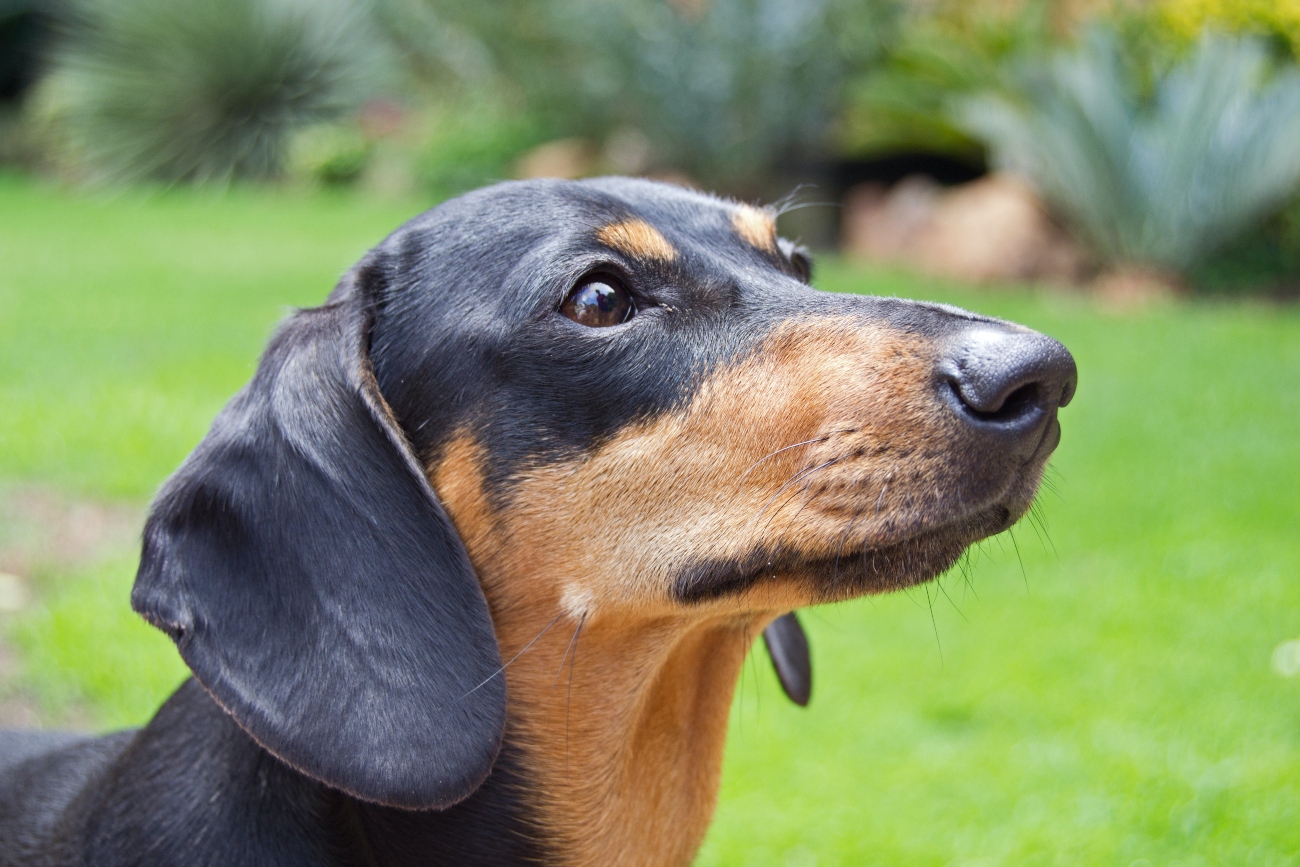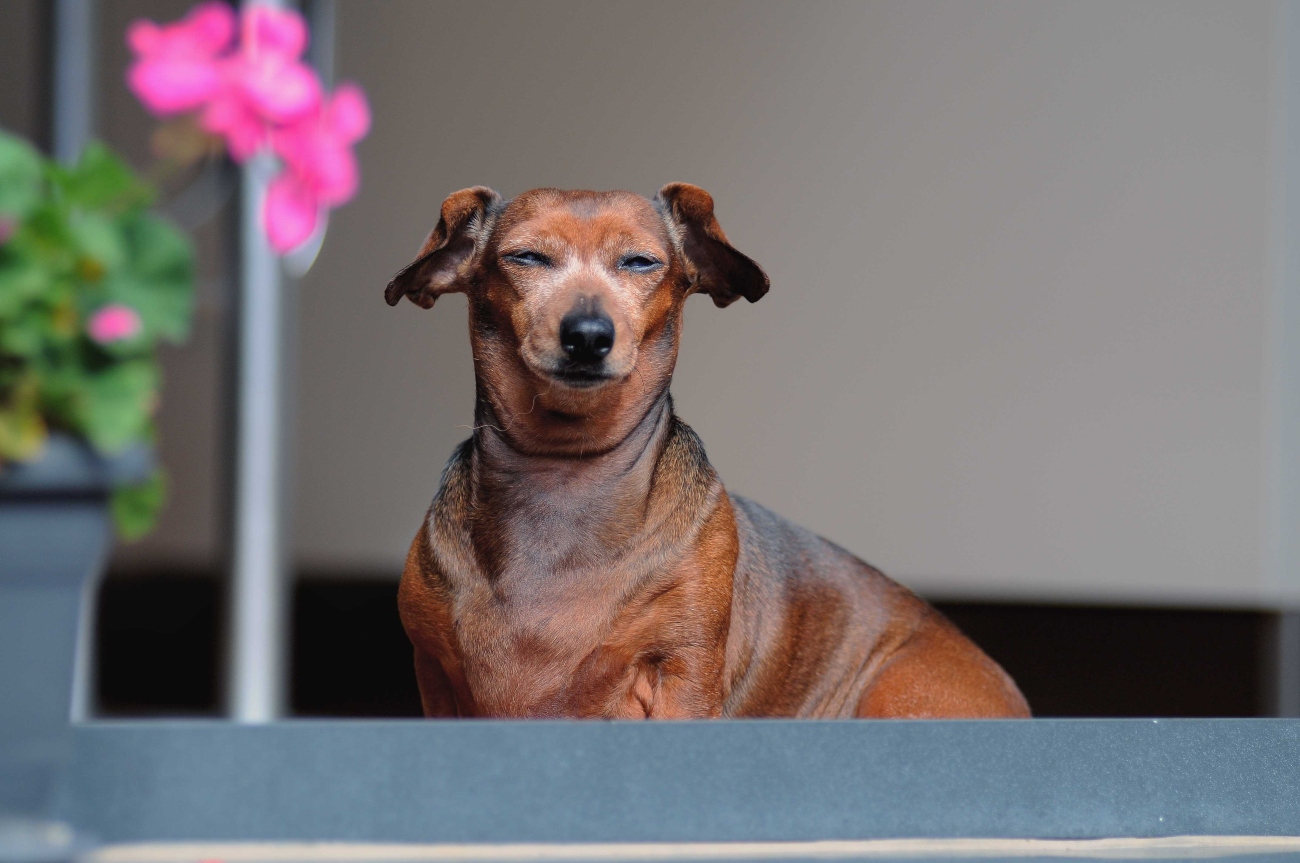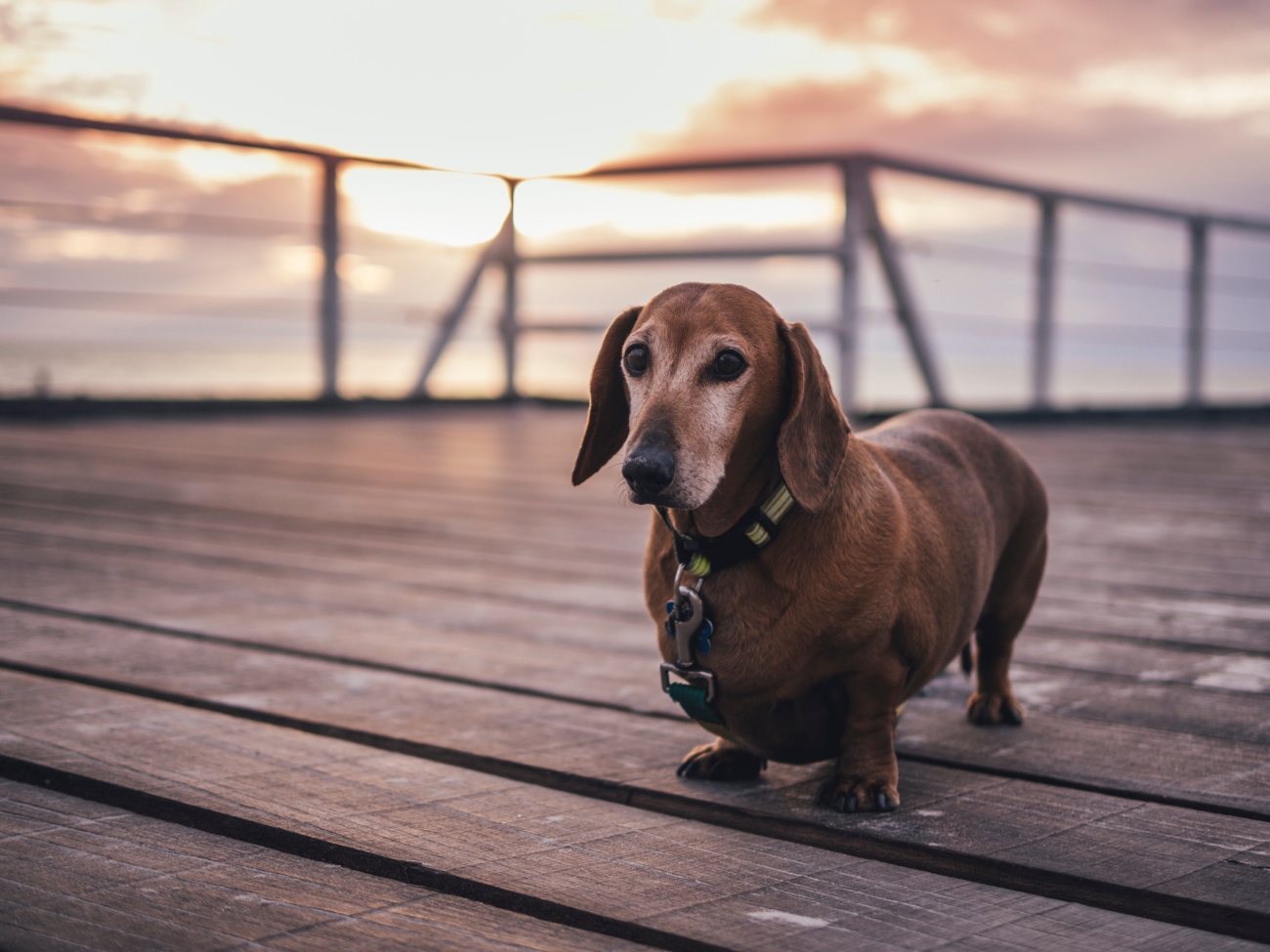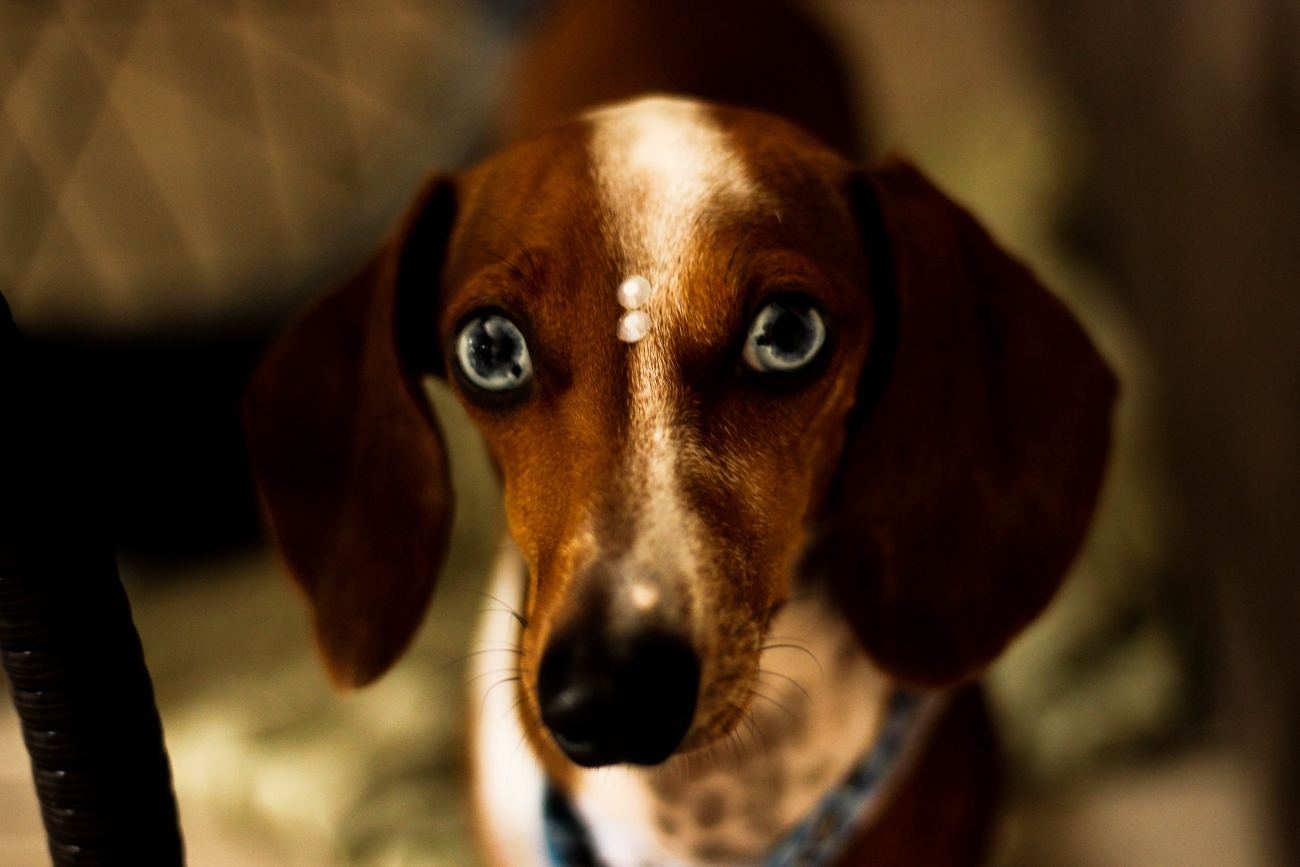
How to care for an old Dachshund
3rd February, 2022
Dachshunds are one of our most intelligent, loyal, playful and loveable dog breeds you could own. As such, they make wonderful pets. Like any other breed, however, they are vulnerable to certain health conditions, and the risks of these tend to increase as they enter old age.
So, how should you look after your beloved sausage dog in their later years? Here is our go-to guide to keeping a senior Dachshund healthy and content. Team these key steps with some pet insurance for older dogs and you will be giving your beloved pet the best chance of an enjoyable old age.

Contents
Chapter 1: Dachshunds: a short history
Chapter 2: What are older Dachshunds like as household pets?
Chapter 3: Common Dachshund health problems
- Intervertebral disc disease
- Heart disease
- Loss of sight
- Dental problems
Chapter 4: What can you do to help your older Dachshund?
- The right food for their age
- Frequent exercise
- Regular vet visits
- A weekly grooming session
- Keep them entertained
Chapter 5: Dachshunds and separation anxiety
Chapter 6: Protecting your aging Dachshund with pet insurance for older dogs
-
Dachshunds: a short history
Also known as sausage dogs, Dachshunds are short-legged, long-bodied canines from the hound family. This large group of hunting dogs also includes Beagles, Basset hounds, Lurchers and Irish Wolfhounds.
Dachshunds come in two different sizes – standard or miniature – and in three different fur types: smooth, wire-haired, or long-haired. That makes for a total of six possible Dachshund permutations!
Originating in 15th-century Germany, these dogs were originally bred to sniff out, chase and flush out badgers, wild boar and other ground-dwelling animals from their burrows. Their powerful paws, long bodies and determined temperament meant that they were perfect for this arduous type of hunting. Indeed, the name comes from the German, meaning 'badger dog'. Miniature Dachshunds, meanwhile, were bred to hunt smaller animals such as rabbits and foxes.
By the middle of the 1800s, Dachshunds were a well-established breed, registered with the Kennel Club. They rose to prominence even more thanks to Queen Victoria, who counted Dachshunds among her favourite dog breeds, and owned several throughout her reign. It was Victoria's German husband, Prince Albert, who introduced her to the breed. Her Dachshunds were mentioned in her personal letters, and some feature in Royal paintings from the era.
Subsequently, Dachshunds also found favour with other Royals – including Princess Margaret, who had a long-haired miniature Dachshund called Pipkin. This dog was mated with one of the Queen’s corgis, resulting in a crossbreed known as the ‘dorgi’. The Queen has since owned 10 of these delightful mixed-breed dogs.
-
What are Dachshunds like as household pets?
Dachshunds make great household pets, as they are loyal and loving. They have quite a strong character, however, so they can be a little more difficult to train than some other breeds. However, given enough patience, they can be effectively house trained and will make very lively, interesting and affectionate dogs for the whole family. Children will particularly enjoy being around Dachshunds, thanks to their playful nature.
Being such lively, intelligent and sociable dogs, Dachshunds do need a fair amount of company and stimulus. They will therefore be happiest in homes where someone is present throughout the day and able to give them the attention they crave. If you and your family are out for most of the day, or even if you work from home but won't have much time to attend to your pet, a Dachshund may not be the ideal pet for you, especially if they’re getting on in years.
You may be better off with a more independent dog breed like Basset hounds, French bulldogs, Greyhounds and Whippets.
It's also worth bearing in mind that Dachshunds do enjoy a good bark, and that – notwithstanding their small size – they have quite a powerful voice! Being such intelligent dogs, you should be able to train some of that love of barking out of them, as long as you begin this training relatively early on in their life.
If you take on an older Dachshund who still loves to bark, you are unlikely to be able to change this at this stage. If you’re having problems with the amount of noise your sausage dog is making, the PDSA recommends seeking some help from an animal behaviourist. We've discussed behaviour problems in older dogs, and what kinds of help are available, elsewhere on our blog.
-
Common Dachshund health problems
These characterful little dogs tend to live longer than most other dog breeds. Indeed, on two occasions a Dachshund has held the Guinness World Record for the oldest living dog.
Typically, members of this breed should live somewhere between 12 and 16 years. That means that, all being well, these loveable, affectionate and playful little dogs are likely to have a long life with you. And, like almost any other dog breed, Dachshunds are prone to certain health problems, many of which become more prevalent or serious in old age.
For this reason, we'd strongly recommend taking out some pet insurance for older dogs, to help with some of the medical costs that may well surface in your dog's latter years. Let's look at a few of the commoner issues now.
Intervertebral disc disease
This condition is essentially an irregularity of the discs that provide some soft cushioning between the back bones, or vertebrae. It's the most common spinal problem in dogs, and the most common cause of spinal surgery.
Made up of a fibrous outer rim and a softer, gelatinous centre, these discs are crucial because they allow movement, as well as supporting the back and acting as shock absorbers when, for example, the dog is running or jumping. When they degenerate, this shock absorption starts to become less effective. This can ultimately lead to hernias and/or compression of the spinal cord.
Both standard and miniature Dachshunds are vulnerable to this complaint. The most common sign of back problems will be pain in the back or neck. Your dog may be yelping with the pain from the compressed discs, and/or they may exhibit an abnormal posture – hunched back with their head down, for example.
They may seem to be panting or shivering; they might even seem reluctant to head out for that exercise that they're usually so enthusiastic for. It's possible they will also have difficulty jumping or moving up and down stairs.
There are a few easy and logical steps that you can take to try and ward off back issues in your Dachshund. For one thing, plenty of exercise is likely to help their long-term health outlook, as it promotes strong muscles and healthy tissues.
Within this encouragement to be active, however, we would actively discourage you from allowing your pet to jump up onto, or down from furniture or any other high or inaccessible places – off the bed, or into the car, for example. These kinds of movements will place unwanted stress on those delicate intervertebral discs.
Lifting or carrying your dog is better in these instances. And whenever you do lift or carry your pet, make sure you support their weight in both the rear and front ends, to avoid causing extra stress on the spinal column. Don’t carry them everywhere, though. Exercise is an important part of keeping their weight at an acceptable level. Obesity can bring problems of its own.

Heart disease
Dachshunds can be prone to degenerative mitral valve disease (DMVD), a health problem in which one of the heart valves develops a leak. This will typically occur when the dog is between 8 and 10 years of age, so in the middle or later years.
In this case, we would simply recommend regular check-ups with your vet. This will significantly increase the likelihood of catching the condition in its earlier stages, before it has been allowed to do much damage. A programme of medication will then be prescribed to treat the problem. Your pet insurance for older dogs may be able to help with the cost of these check-ups and/or whatever medication is required.
It's also important to keep your pet's weight at a sensible level, so that the heart isn't being made to work harder than normal. A combination of a sensible diet (we'll talk more about diet further down) and, again, plenty of exercise will be the key here. Standard Dachshunds should typically weigh somewhere between 9kg and 12kg, while miniatures should tip the scales somewhere around 4kg or 5kg.
Loss of sight
Dachshunds, like many other breeds, are prone to gradual loss of sight – or over a period of months or years.
This progressive blindness can have a wide variety of causes. Common causes include cataracts, which are changes to the lens within the eye or eyes. Cataracts are more likely to develop in older dogs, as well as in diabetic dogs. Dachshunds are one of the breeds most prone to diabetes, so this will be an additional factor to look out for.
Blindness in your dog can make itself noticeable in quite a few ways. Some common signs to be on the lookout for include any obvious changes in the appearance of the eye itself, which might indicate glaucoma, for example.
Aside from this, be aware of any changes in your dog's behaviour. They may be more clumsy than usual, for example, or they may not want to go out at night. You might become aware that they are more easily startled or anxious than usual – or you may notice them bumping into furniture, walls, or people.
Walks can become a very different, more confusing and less enjoyable experience for them – they may get lost more easily or seem to be walking much more slowly and gingerly than usual, giving off a general sense of confusion and disorientation.
Perhaps they can't find those much-loved toys or balls, or that all-important food or water bowl, that they normally have no trouble locating.
You can read a fuller explanation of some common signs of blindness in your dog elsewhere on our Pets News and Advice pages.
There are quite a few things – some obvious, some less so – that you can do to make your blind or partially sighted dog's life easier. Fundamentally, dogs are highly adaptable animals and quickly learn to do most of the things they have always done, even with impaired vision. However, you can definitely help them to adapt quickly and painlessly.
For instance, try to keep their home the same as it has always been, and avoid making any sudden changes to the layout of your house. In particular, keep their water and food bowls in the same place so they know where to find them.
Elsewhere, you can 'pet-proof' your home effectively by locating and removing any likely hazards. These include furniture or other items with sharp edges, plus any exposed electrical wires.
When you’re out walking, look out for hazards such as low branches, thorny bushes, or uneven or slippery surfaces that your aging pup might not see until it’s too late.
Dental problems
Your Dachshund may experience some problems with their teeth in older age. Dental diseases in Dachshunds can be painful, and can result in dogs losing their appetite. The effects of that loss of appetite, in turn, can extend to unsafe weight loss, and their coat becoming dishevelled through a lack of the correct vitamins and minerals.
To help combat the effects of dental problems, you should clean your Dachshund's teeth every day. They may resist this daily ritual: if so, try dental treats and dental sticks instead. You should also take them to the vet for annual oral check-ups and cleaning routines. Your vet will be well placed to diagnose any dental disease and to advise you on a suitable cleaning regime. Make sure, if possible, that your pet insurance for older dogs covers any dental procedures needed. Dental cover comes as standard on Petwise policies.
-
What can you do to help your older Dachshund?
Aside from keeping an eye out for any signs of the conditions above, there are a few really useful things you can do to keep your senior dog healthy and happy. These include:
Feed them the right food for their age
As dogs grow older – even a naturally energetic and inquisitive breed like the Dachshund – they will inevitably start to become less active. For this reason, it's really important to feed your older dog a diet that's suitable for their age – including a reduced number of calories to compensate for those reduced levels of exercise.
Dachshunds are prone, like many other breeds, to obesity in later life. This condition brings with it a number of potential dangers and health risks. It can lead to more serious conditions, for example, and is also likely to shorten your beloved pet's lifespan.
For this reason, you should feed your older dog a specialist senior dog diet, with lower fat levels and fewer calories.
Heart disease, which we discussed briefly further up this article, is another condition that can affect older dogs, Dachshunds in particular. And again, there are changes you should make to your dog's nutrition if they are affected by this condition. Specifically, they will require a diet containing lower levels of sodium.
Other diets will target ailments such as joint problems and allergies, both of which can occur fairly commonly in older dogs – including the Dachshund breed.
More generally, though, senior dogs should be fed a more bespoke diet that contains exactly the right amount of calories, and the correct balance of nutrients, to enable them to live a happy, healthy and active old age. Your vet will be able to advise on what diet will best suit your pet.
Frequent exercise
When it comes to keeping your older pet healthy, active and at a suitable weight, eating properly is one half of the equation. The other important element is, of course, their exercise regime.
Your older dog won't be as mobile or energetic as they once were, and their appetite for exercise may tail off a little in their later years. However, exercise is no less important than it was when they were younger. In fact, in some ways it can become even more crucial.
As we've seen, Dachshunds' very particular body shape can leave them prone to certain issues such as obesity and back problems. Given this, a programme of regular exercise is all-important.
The chances are that your Dachshund has led a fairly active life up to this point, and should be well able to continue exercising – albeit with some modifications – into their old age.
However, if your Dachshund is not used to exercise, it will be important to start slowly and gently, and build up the intensity gradually. Begin with small walks and/or light jogs, and add a little distance when they seem completely happy and at ease – and not before.
Be aware that each dog will have their own stamina and energy levels, and try to tailor their regime accordingly. Once more, this is an area where your vet can be a really useful source of advice and suggestions. Or you can call the 24-Hour Vet Helpline if you’re a Petwise policyholder, and get advice that way.
Regular vet visits
Alongside good nutrition and regular exercise, another important way to look after your senior Dachshund is to maintain regular check-ins with your vet. As dogs grow older, their immune systems will inevitably weaken, putting them more at risk of a wide range of illnesses. These illnesses can remain hidden from view for some time, which is why a regular vet check-up is so crucial.
We recommend a check-up every six months as your Dachshund enters their later years. And, if the costs of these regular visits, and any treatment that may result, seem daunting, don't worry. Your pet insurance for older dogs may be able to help with some of the costs.
A weekly grooming session
Grooming your Dachshund is a fun, bonding activity for both of you. Not only that: in the case of long-haired and wire-haired Dachshunds especially, it's essential for keeping their fur in good condition. This is because, as they become less active and spend more time lying around, their fur can grow dishevelled, matted and untidy.
As well as being a great way to spend time together, a daily brush of their fur should help keep any knots and tangles at bay. An occasional shampoo session is also a good idea. See a professional dog groomer if you’re not confident grooming them yourself.
And don’t forget their nails. If your Dachshund is mainly plodding around the house on carpet, its nails could become long and uncomfortable if they’re not being worn down. Invest in some clippers or ask your dog groomer to take care of this for you.
Keep them entertained
Your older Dachshund may be exercising less, but their need for stimulus won't have decreased. A dog that lies around all day without getting any stimulus will be at risk of mental deterioration and, eventually, senility.
So, in these later years, a small range of interesting toys is a really good idea. A food puzzle, or kong toy for example – where they have to get to the food or treat by cracking some sort of puzzle – will keep them active and stimulated if you’re busy with other things.

Dachshunds and separation anxiety
Many owners will tell you that Dachshunds love being around their owners. The animal charity Dogs Trust recommends not leaving a dog for more than four hours at a time on their own. Dachshunds can be prone to suffering from separation anxiety if left alone for long periods.
Not only could that deep, noisy bark reappear and disturb your neighbours, but they could also display signs of separation anxiety. We’ve talked about these elsewhere on our blog, but signs can include:
- Pacing, panting, drooling, hiding or trembling before you leave the house.
- Toileting in the house when they’re otherwise toilet trained.
- Chewing and pawing at doors and windows.
- Not eating while you’re away
Even though your older dog may not be able to go out as much as before, they still crave attention from you so don’t leave them alone for too long.
-
Protect your aging Dachshund with pet insurance for older dogs
We hope this go-to-guide has helped you understand your Dachshund a little bit more. Or opened your eyes to what life could be like with a so-called sausage dog if you’re thinking of adopting an older pet.
Does this sound like the breed for you? If so, we can help you keep them protected with our specialist pet insurance for older dogs.
Petwise policyholders can benefit from:
- A 24-Hour Vet Helpline
- Senior food contribution
- Dental cover as standard
Check out our customer reviews on Instagram and contact us today to find out more about pet insurance for older dogs.